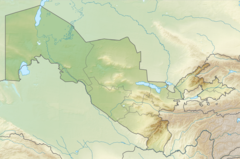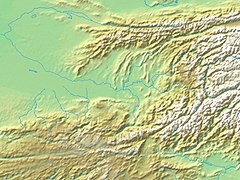Sokh snakes
Appearance
| Sokh snakes | |
|---|---|
 Two snakes, Sokh, Ferghana valley, 3rd millennium BCE (front view).[1] | |
| Material | Serpentine |
| Created | 3rd millennium BCE, ca. 2000 BCE |
| Place | Sokh, Ferghana valley, Uzbekistan |
| Present location | Tashkent, National Museum of Uzbek History |
The Sokh snakes are two snakes made in stone that were discovered in Sokh, Ferghana valley, Uzbekistan in 1899.[1] It is dated to the 3rd-2nd millennium BCE, and displays stylistic similarities with the contemporary cultures of Mesopotamia, leading archaeologist Philip Kohl to suggest that it was actually imported from Elam, where similar objects can be found.[2]
The culture to which the stone snakes belonged may have been a predecessor, and may have contributed to the formation, of the Chust culture (ca. 1500 to 900 BCE) of Ferghana.[3]

References
[edit]- ^ a b "Splendeurs des oasis dOuzbekistan, p.12" (PDF).
- ^ Gorbunova, N. G. (1978). The Culture of Ancient Ferghana: VI Century B.C. - VI Century A.D. British Archaeological Reports. p. 18. ISBN 978-0-86054-363-3.
to the 2 nd and 3rd millennia B.C. , the most important is a stone relief with a snake motif , found in Sokh in 1899...
- ^ Starr, S. Frederick (18 December 2014). Ferghana Valley: The Heart of Central Asia. Routledge. p. 5. ISBN 978-1-317-47066-3.



